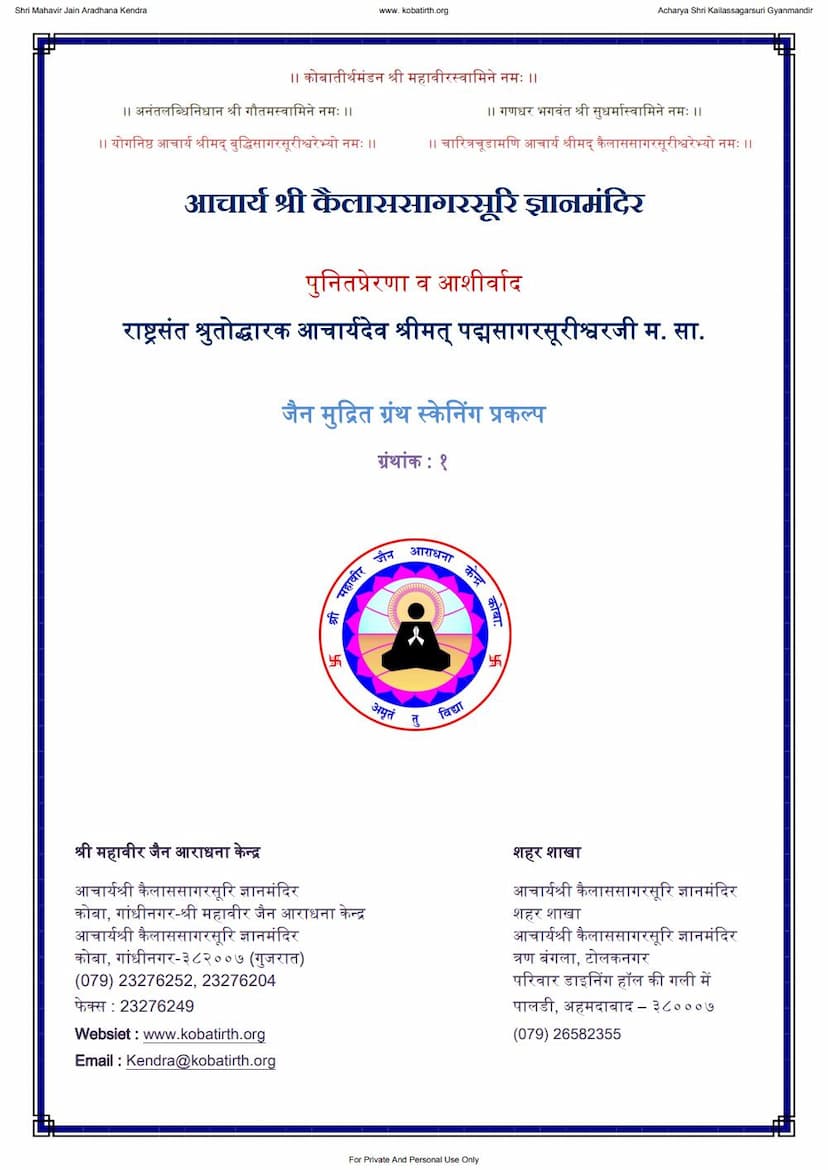Agam 04 Ang 04 Samvayang Sutra Shwetambar
Added to library: September 1, 2025

Summary
This is a summary of the Jain text Samavāyāṅga Sūtra, specifically the fourth Anga (section) of the Shvetambara canon, as presented in the provided pages. The text is a comprehensive compilation of Jain scriptures, often referred to as Agamas.
Overall Purpose and Significance:
The Samavāyāṅga Sūtra is a foundational text in Jainism, belonging to the canon of Shvetambara Agamas. It is considered a vital source for understanding the structure, classification, and fundamental principles of Jain philosophy and cosmology. The presented edition is a revised and edited version by Acharya Shri Anandasagar Surishwarji Maharaj and compiled by Acharya Shri Purnachandrasagarji Maharaj.
Key Themes and Content:
The primary focus of the Samavāyāṅga Sūtra is to systematically enumerate and classify various Jain doctrines, concepts, entities, and numerical categories. It aims to provide a structured and organized overview of the Jain worldview. Based on the extensive numerical listings and categorizations found within the text, the following key themes are evident:
- The Twelve Angas (Dvādaśāṅga): The text begins by listing the twelve constituent Angas of the Jain canon, emphasizing the importance of the fourth Anga, the Samavāyāṅga itself. The Angas are considered the core teachings of Lord Mahavir.
- Numerical Classifications: A significant portion of the Samavāyāṅga Sūtra is dedicated to enumerating and detailing concepts based on numerical sequences, particularly from 1 up to at least 100 and beyond, as evidenced by the page content. This includes:
- Entities and Beings: Classifying various types of beings, realms (like hellish beings, gods, humans, animals), and their attributes.
- Time and Lifespans: Detailing lifespans (āyuṣ) and durations of existence in different realms and among various classes of beings, often expressed in complex numerical terms of Paliyopamas and Sāgaropamas.
- Cosmological Details: Providing numerical descriptions of the universe, including the dimensions of continents (like Jambudvīpa), mountains, and celestial abodes.
- Religious Practices and Concepts: Enumerating principles, vows, austerities, classifications of karma, and other spiritual concepts in numerical frameworks.
- Specific Jain Doctrines: Detail on the eighteen principles (Prakṛtis) of karma, the six collections of souls (Jīva Nikāyas), the five great vows (Mahāvratas), and numerous other classified sets of Jain teachings.
- The History of Jain Councils (Vācanās): The introductory pages (6-10) provide a detailed historical account of the six significant councils (Vācanās) that were held to preserve and codify the Jain Agamas after Lord Mahavir's demise. These councils were crucial in preventing the loss and distortion of the sacred texts due to adverse circumstances and the passage of time. The text highlights the efforts of prominent Acharyas in these endeavors.
- The Importance of Śruta Knowledge (Scriptural Knowledge): The text repeatedly emphasizes the profound importance of scriptural knowledge (Śruta Jñāna) as a guiding light for spiritual progress, especially in overcoming delusion and ignorance. The Agamas are presented as the very words of Lord Mahavir.
- Genealogies and Lineages: The latter part of the text (from around page 102 onwards) lists the lineages of Tirthankaras, their parents, disciples, and attendant figures, providing a historical and genealogical framework for understanding the propagation of Jainism.
Editorial and Publishing Information:
- Author/Editor: Acharya Shri Anandasagar Surishwarji Maharaj (for revision and editing), Acharya Shri Purnachandrasagarji Maharaj (for compilation and manuscript work).
- Publisher: Jainanand Pustakalay, Surat.
- Institution: Shri Mahavir Jain Aradhana Kendra, Acharya Shri Kailassagarsuri Gyanmandir, Kobatirth, Gujarat.
- Project: Jain Mudrit Granth Scanning Project.
- Edition: First Edition, Samvat 2061 (Vikram era).
Overall Impression:
The Samavāyāṅga Sūtra, as presented here, is a meticulously detailed and encyclopedic work. It serves as a foundational reference for Jain scholars and practitioners, offering a structured and comprehensive understanding of the Jain spiritual and cosmological framework through extensive numerical classification and enumeration. The historical context provided regarding the councils underscores the commitment of the Jain tradition to preserving its sacred knowledge across centuries.